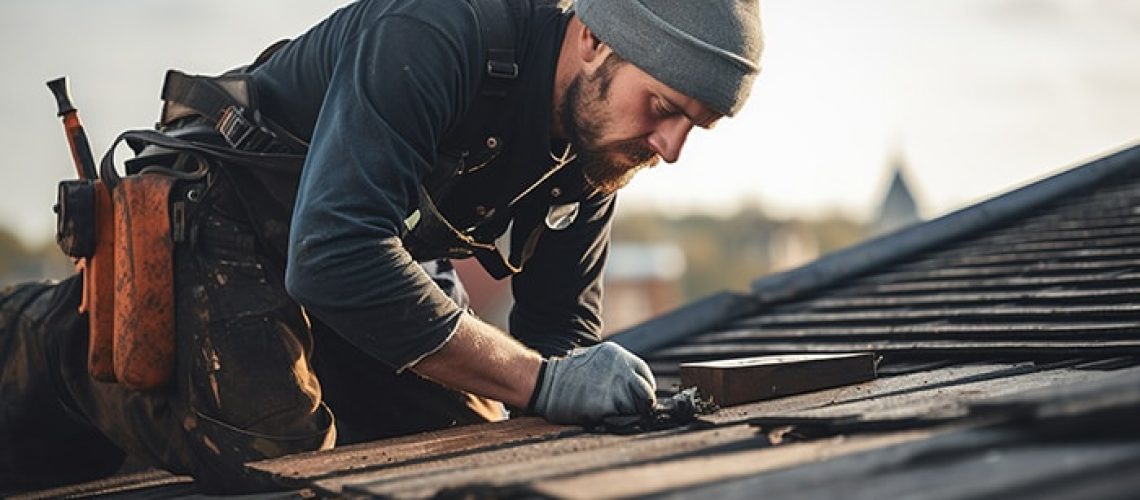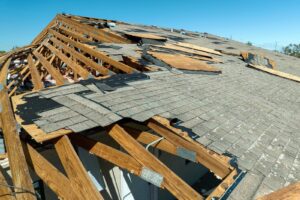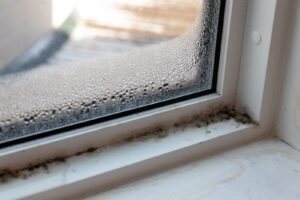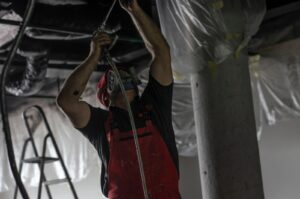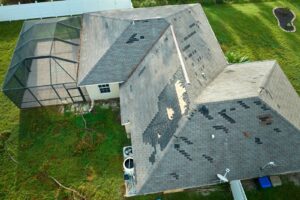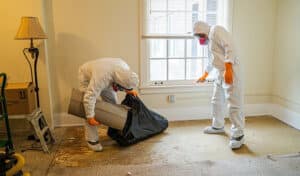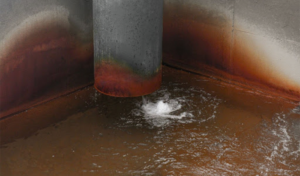Storm and wind damage pose significant challenges to homeowners and businesses alike. Each year, countless properties are affected by wind or storm damage, leaving many property owners grappling with the aftermath.
Among the most vulnerable aspects of any building is its roof, a critical line of defense against the elements. It’s essential to understand the extent of wind or storm damage that necessitates a roof replacement. Repairing or replacing your roof helps maintain the integrity of a structure and the safety and security of those within it.
In this article, we’ll delve into the critical aspects of wind damage on roofs, including signs of wind damage. We’ll help you discern when a repair is sufficient and when a total roof replacement becomes necessary.
Understanding wind damage to roofs
Wind damage to roofs is a more complex phenomenon than many might realize. It’s not just the strength of the wind that matters but also how it interacts with the structure of a building.
When wind blows over a roof (especially during a severe weather event), it creates a complex system of different air pressures. The edges and corners of roofs are particularly vulnerable, as these areas experience higher wind pressures. This sometimes leads to lifting shingles or roofing materials, a primary sign of wind damage.
The different types of wind damage vary significantly. One common form of wind damage is the lifting of shingles. In more severe cases, entire roofing sections are compromised or lifted up. The gaps left from lifted shingles allow water and other debris to infiltrate the roof and damage the structure holding it up.
Debris impact is another concern. During a storm, wind can carry branches, outdoor furniture, or other objects with enough force to damage the roof surface. These impacts can lead to punctures or cracks. This kind of damage is not always immediately visible but compromises the roof’s integrity over time.
Several factors influence the severity of wind damage to a roof. The age of the roof is a critical factor; older roofs may have weakened materials or previous wear that makes them more susceptible to damage. In addition, some older roofs are not made with the same quality of materials available now and are, therefore, more susceptible to damage.
The quality and type of roofing material also play a significant role in how well a roof stands up to damage. For instance, asphalt shingles might react differently to high winds than metal roofing. The roof’s design and the direction it faces also affect how wind impacts it. Moreover, previous damage or repairs to the roof often leave it more vulnerable to future wind events.
Signs of wind damage to your roof
Some signs of damage on your roof are immediately visible, while others are more subtle and require a closer look. Visible signs of wind damage are often the easiest to spot. Missing shingles are a clear indicator that your roof has been compromised. High winds can rip shingles from the roof, leaving exposed areas vulnerable to water damage and further deterioration.
Bent or lifted roof shingles are an obvious sign of wind damage. This kind of damage occurs when the edges of shingles are lifted by the wind, breaking the seal that keeps them flat. Over time, this leads to further lifting and potential leaks.
Granule loss is another visible sign, often overlooked. Granules protect the shingle from UV rays and weathering. When these are stripped away, it significantly reduces the lifespan of your roof.
However, not all wind damage is immediately apparent. Hidden signs, such as leaks, are more insidious. After a storm, it’s not uncommon for homeowners to discover water intrusion in their attics or upper floors. This can result from wind lifting shingles and allowing water to seep through.
Structural weakening is another hidden concern. Repeated exposure to strong winds loosens nails and adhesives, compromising the roof’s overall stability. Water damage, mold, or rot can also damage the materials supporting the roof and compromise structural integrity.
When does wind damage lead to roof replacement?
Determining when to repair or replace a roof following wind damage requires careful consideration. There are specific scenarios where replacement becomes necessary. If wind damage is extensive and affects a significant portion of the roof, repairs may not be enough to restore the roof’s integrity. This is particularly true in cases where the damage has led to structural weaknesses in the roofing system.
Additionally, if the roof is nearing the end of its expected lifespan, investing in repairs might not be cost-effective. In such cases, replacing the roof is often a more prudent choice.
Cumulative damage plays a critical role in deciding between repairing and replacing. A roof that has undergone multiple repairs over time may have compromised structural integrity. Each repair, while necessary, impacts the overall resilience of the roof. Repeated damage in the same areas weakens the roofing materials and the underlying structure, making a total replacement a more sensible option.
While repairs might be less expensive in the short term, they add up over time, especially if the roof continues to be susceptible to wind damage. On the other hand, a new roof offers better long-term value even though it is a more significant upfront investment. Modern roofing materials and techniques provide improved durability and resistance to weather elements, which is a wise investment for areas prone to high winds.
The process of roof replacement
After handling wind damage cleanup, the first step in this process is a comprehensive inspection to determine the full extent of the damage. This inspection is important not only for planning the replacement but also for supporting insurance claims.
Once the inspection is complete and insurance matters are settled, the next step is material selection for the new roof. When considering the various available roofing materials, consider factors like durability, aesthetics, and budget. You will also want to consider the weather patterns of your area and what your building is able to support.
Some popular roofing materials include the following:
- Asphalt shingles: Cost-effective and widely available, these shingles are easy to install and repair. They also come in a variety of colors. These shingles are, at times, vulnerable to high winds and temperatures.
- Metal roofing: Metal roofing has a long lifespan and is highly durable. It is also fire-resistant and energy-efficient. Metal roofing is lightweight and is easy to install over old roofs. It does have a higher initial cost and can be noisy during rain or hail.
- Wood shakes or shingles: These natural shingles are beautiful and offer some insulation. If sourced responsibly, then they are eco-friendly too. They aren’t fire resistant unless treated and require regular maintenance to prevent rot and mold.
- Slate roofing: Slate roofing is extremely durable and long-lasting. They are also fire-resistant and low maintenance. They are expensive and heavy, so they require strong structural support.
- Clay or concrete: These fireproof tiles are energy-efficient and durable. They have a long lifespan and are resistant to rot and insect damage. They are one of the heavier and more expensive options available.
- Synthetic roofing (rubber, plastic, polymer): Synthetic roofing can be designed to mimic the look of other roofing materials. It is lightweight and low maintenance. It is also often made of recycled materials. This type of roofing is relatively new on the market, and the quality of the product varies between manufacturers.
After material selection, the construction of a new roof can begin. The timeframe for roof replacement varies depending on the size of the roof and the materials chosen.
Protecting your roof from future wind damage
Protecting your roof from future wind damage involves a combination of proactive preventative measures and regular maintenance.
One key preventative step is the installation of wind-resistant roofing materials. These are designed to withstand higher wind speeds and offer greater durability during storms. Additionally, ensuring that your roof is properly installed with secure fastening systems reduces the risk of wind damage significantly.
Regular maintenance is crucial in identifying and addressing potential vulnerabilities. Regular maintenance includes routine checks for loose or damaged shingles, ensuring gutters and downspouts are clear of debris, and trimming overhanging tree branches that could pose a threat during high winds. These simple actions go a long way in maintaining the structural integrity of your roof.
However, professional inspections are the most effective way to safeguard your roof. Regular roof inspections, especially after severe weather events, help identify minor damages before they escalate into major problems. By staying ahead of repairs and understanding the specific needs of your roof, you significantly enhance its resilience against future wind damage.
Why choose Restoremasters to restore your property
Promptly addressing wind damage is crucial for the safety and longevity of your property. At Restoremasters, we’ve witnessed firsthand the havoc that wind and storm damage can wreak on roofs and property owners. With over two decades of experience in the restoration industry, our team has developed a keen eye for assessing damage and determining the most effective course of action.
Whether it’s a few missing shingles or a roof that’s been compromised to its core, we understand that each situation is unique and requires a tailored approach. Our expertise in this field is not just about fixing what’s broken; it’s about restoring peace of mind to our clients, knowing that their sanctuary is secure and resilient against future storms.
We pride ourselves on timely completion and unwavering commitment to customer satisfaction. When you choose Restoremasters, you’re gaining a partner committed to restoring and enhancing the value of your home or business. Contact Restoremasters today!

